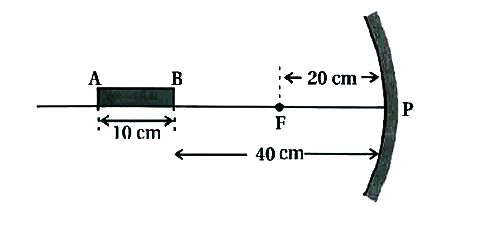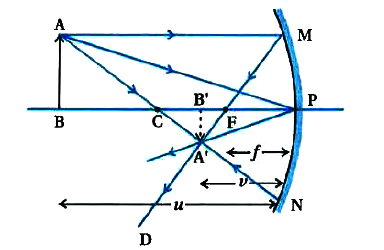Answer the following questions:
(e) When viewing through a compound microscope, our eyes should be positioned not on the eyepiece but a short distance away from it for best viewing. Why? How much should be that short distance between the eye and eyepiece?Solution in Gujrati
Image of objective in eye-piece is called eye ring. All rays coming from object pass through eye ring after refracting through objective. Hence, it is an ideal position to observe by eye. Ifwe keep our eyes close to eye-piece, then we cannot get more light and the area to observe will also decrease. Ifwe keep our eye on eye ring and the area of eye lens is greater than or equal to eye ring than eye will obtain all the rays refracted from objective. The position of eye ring depends on the distance between objective and eye-piece. When you observe by keeping eye at one end of microscope, then the ideal distance between eye and eye-piece adjusted in design of microscope.
Topper's Solved these Questions
- BOOK - KUMAR PRAKASHANCHAPTER - RAY OPTICS AND OPTICAL INSTRUMENTSEXERCISE - SECTION-B (NUMERICALS)(NUMERICAL FROM .DARPAN. BASED ON TEXTBOOK )12videos
RAY OPTICS AND OPTICAL INSTRUMENTS
- BOOK - KUMAR PRAKASHANCHAPTER - RAY OPTICS AND OPTICAL INSTRUMENTSEXERCISE - SECTION-C (NCERT EXEMPLAR SOLUTION) (MULTIPLE CHOICE QUESTIONS (MCQs))16videos
RAY OPTICS AND OPTICAL INSTRUMENTS
- BOOK - KUMAR PRAKASHANCHAPTER - RAY OPTICS AND OPTICAL INSTRUMENTSEXERCISE - SECTION-B (NUMERICALS)(NUMERICAL FROM TEXTUAL ILLUSTRATIONS)17videos
RAY OPTICS AND OPTICAL INSTRUMENTS
- BOOK - KUMAR PRAKASHANCHAPTER - MOVING CHARGES AND MAGNETISMEXERCISE - SECTION D (MCQs ASKED IN COMPETITIVE EXAMS)34videos
MOVING CHARGES AND MAGNETISM
- BOOK - KUMAR PRAKASHANCHAPTER - SAMPLE QUESTION PAPER EXERCISE - PART-B SECTION-C5videos
SAMPLE QUESTION PAPER
Similar Questions
As shown in the figure, a thin rod AB of length 10 cm is placed on the principal axis of a concave mirror such that it.s end B is at a distance of 40 cm from the mirror. If the focal length of the mirror is 20 cm, find the length of the image of the rod
 09:19View Solution
09:19View SolutionA ray of light incident at an angle θ on a refracting face of a prism emerges from the other face normally. If the angle of the prism is 5∘ and the prism is made of a material of refractive index 1.5, the angle of incidence is
09:19View SolutionSuppose that the lower half of the concave mirror.s reflecting surface as shown in figure is covered with an opaque (non-reflective) material. What effect will this have on the image of an object placed in front of the mirror ?
 09:19View Solution
09:19View SolutionElectric charge Q having mass M moves on a circular path of radius R with velocity →v, perpendicular to uniform magnetic field B. When a particle completes one revolution, work done by the field is _______
View SolutionTwo charges –q and +q are located at points (0, 0, –a) and (0, 0, a), respectively.
(a) What is the electrostatic potential at the points (0, 0, z) and (x, y, 0) ?
(b) Obtain the dependence of potential on the distance r of a point from the origin when r/a>>1 .
(c) How much work is done in moving a small test charge from the point (5,0,0) to (–7,0,0) along the x-axis? Does the answer change if the path of the test charge between the same points is not along the x-axis?02:35View SolutionAnswer the following questions : (a) The angle subtended at the eye by an object is equal to the angle subtended at the eye the virtual image produced by a magnifying glass. In what sense then does a magnifying glass provided angular magnification ? (b) In viewing through a magnifying glass, one usually positions one's eye very close to the lens. Does angular magnification change if the eye is moved back ? ( c) Magnifying power of a simple a convex lens of smaller and smaller focal length and achieving greater and greater magnifying power ? (d) Why must both the objective and eye piece of a compound microscope have a short focal lengths ? (e) when viewing through a compound microscope, our eyes should be positioned not on the eye piece, but a short distance away from it for best veiwing, why ? How much should be that short distance between the eye and eye piece ?
View Solutiona) The anlge subtended at the eye by an object is equal to the angle subtended at the eye by the virtual image produced by a magnifying glass. In what sense then does a magnifying glass provide angular magnifications?
b) in viewing through a magnifying glass, one usually positions one's eyes very close to the lens. Does angular magnification change if the eye is moved back?
c) magnifying power of a simple microscopes is inversely proportional to the focal length of the lens. What then stops us from using a convex lens of smaller and smaller focal length and achieving greater and greater magnifying power?
d) Why must both the objective and the eyepiece of a compound microscope have short focal lengths?
e) When viewing through a compound microscope, our eyes should be positioned not on the eyepiece but a short distance away from it fot best veiwing. Why? How much should be that short distance between the eye and eyepiece?View Solutiona) The anlge subtended at the eye by an object is equal to the angle subtended at the eye by the virtual image produced by a magnifying glass. In what sense then does a magnifying glass provide angular magnifications? b) In viewing through a magnifying glass, one usually positions one's eyes very close to the lens. Does angular magnification change if the eye is moved back? c) Magnifying power of a simple microscopes is inversely proportional to the focal length of the lens. What then stops us from using a convex lens of smaller and smaller focal length and achieving greater and greater magnifying power? d) Why must both the objective and the eyepiece of a compound microscope have short focal lengths? e) When viewing through a compound microscope, our eyes should be positioned not on the eyepiece but a short distance away from it fot best veiwing. Why? How much should be that short distance between the eye and eyepiece?
01:20View Solutionसंयुक्त सूक्ष्मदर्शी से देखते समय उत्तम दृष्टि के लिए नेत्र को पत्रिका के बिल्कुल पास नहीं रखना चाहिये अपितु पत्रिका से कुछ दूरी पर रखना चाहिये, क्यों? नेत्र और पत्रिका के बीच की दूरी कितनी होनी चाहिये?
03:11View Solutionसंयुक्त सूक्ष्मदर्शी द्वारा देखते समय सर्वोत्तम दर्शन के लिए हमारे नेत्र, नेत्रिका पर स्थित न होकर उससे कुछ दूरी पर होनी चाहिए। क्यों ? नेत्र तथा नेत्रिका के बीच की यह अल्प दूरी कितनी होनी चाहिए ?
04:33View Solutione) When viewing through a compound microscope, our eyes should be positioned not on the eyepiece but a short distance away from it for best viewing. Why? How much should be that short distance between the eye and eyepiece ?
View SolutionWhen viewing through a compound microscope , our eyes should be positioned not on the eyepiece but a short distance away from if for best viewing . Why ? How much should be the short distance between the eye and the eyepiece ?
View SolutionA : When viewing through a compound microscope, our eyes should be positioned not on the eye piece but a short distance away from it for best viewing. R : The image of the objective in the eye-piece is known as 'eye-ring' and if we position our eyes on the 'eye-ring' and the area of the pupil of out eye is greater or equal to the area of the eye ring, our eyes will collect all the light refracted by the objective.
01:55View SolutionWhen viewing through a compound microscope, our eyes should be positioned not on the eyepiece, but a short distance away from it for best viewing . why ? How much should be that short distance between the eye and eyepiece?
View SolutionAnswer the following questions: (e) When viewing through a compound microscope, our eyes should be positioned not on the eyepiece but a short distance away from it for best viewing. Why? How much should be that short distance between the eye and eyepiece?
03:18View SolutionAnswer the following questions:
(d) Why must both the objective and the eyepiece of a compound microscope have short focal lengths?03:43View Solution

